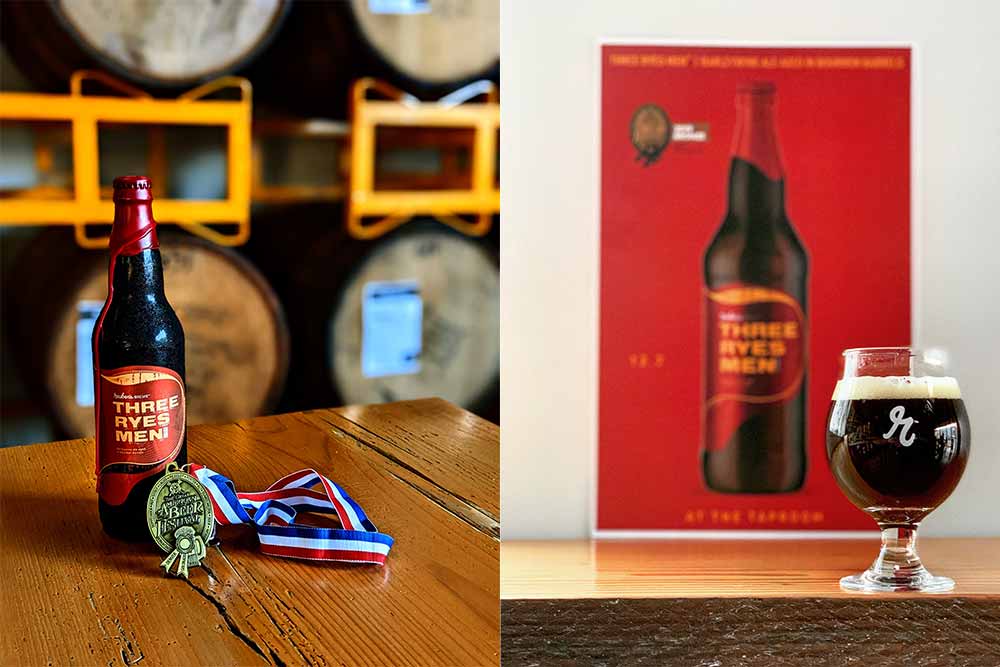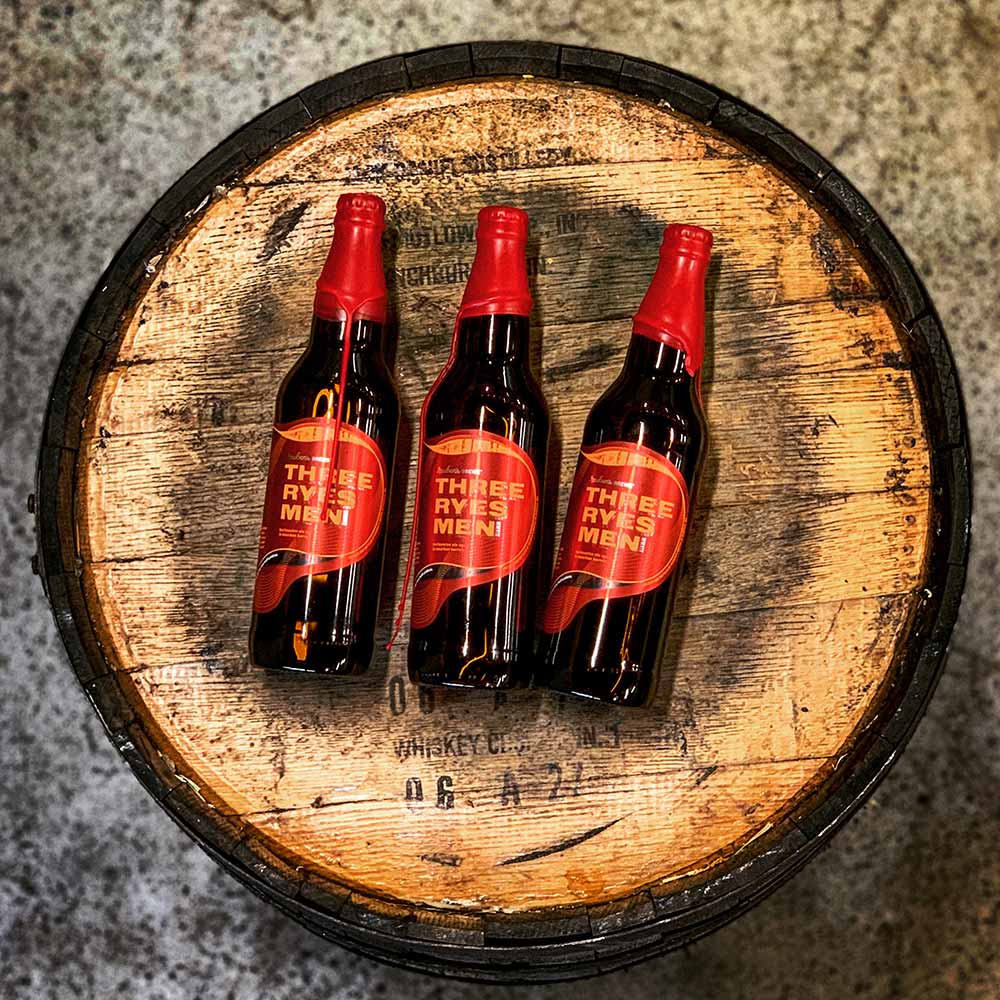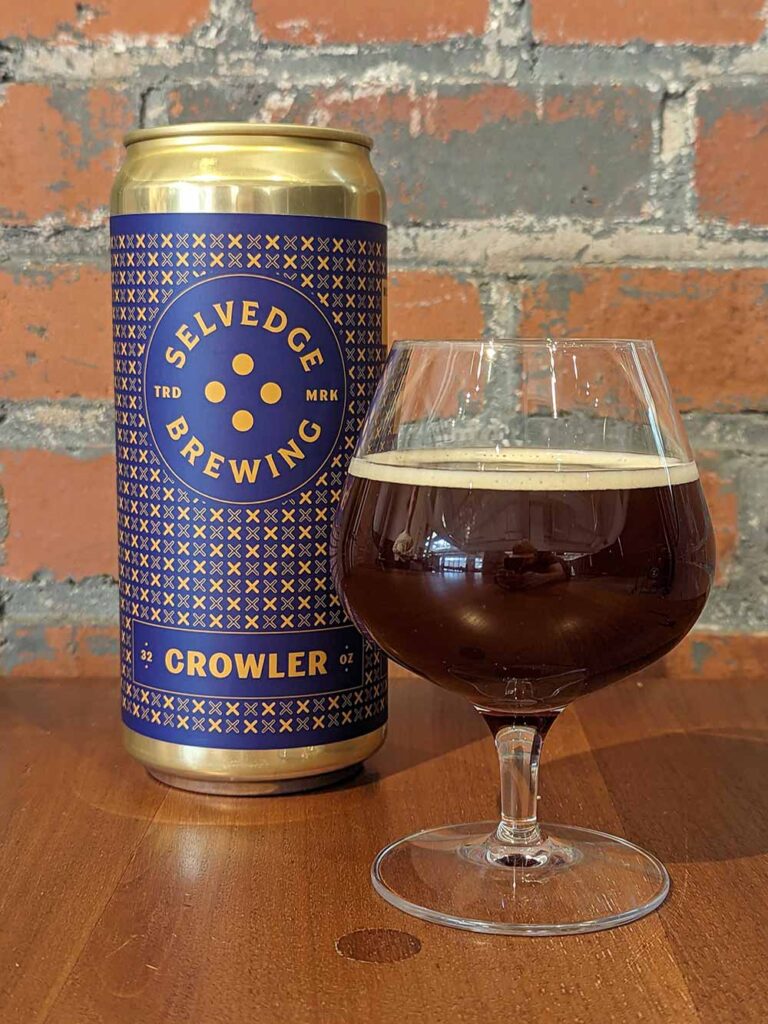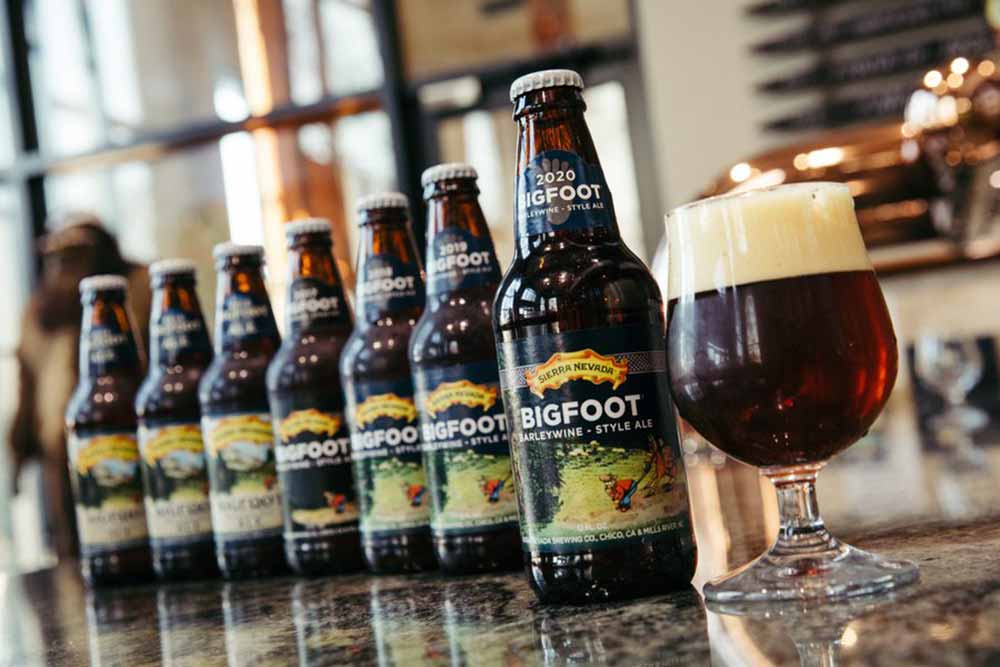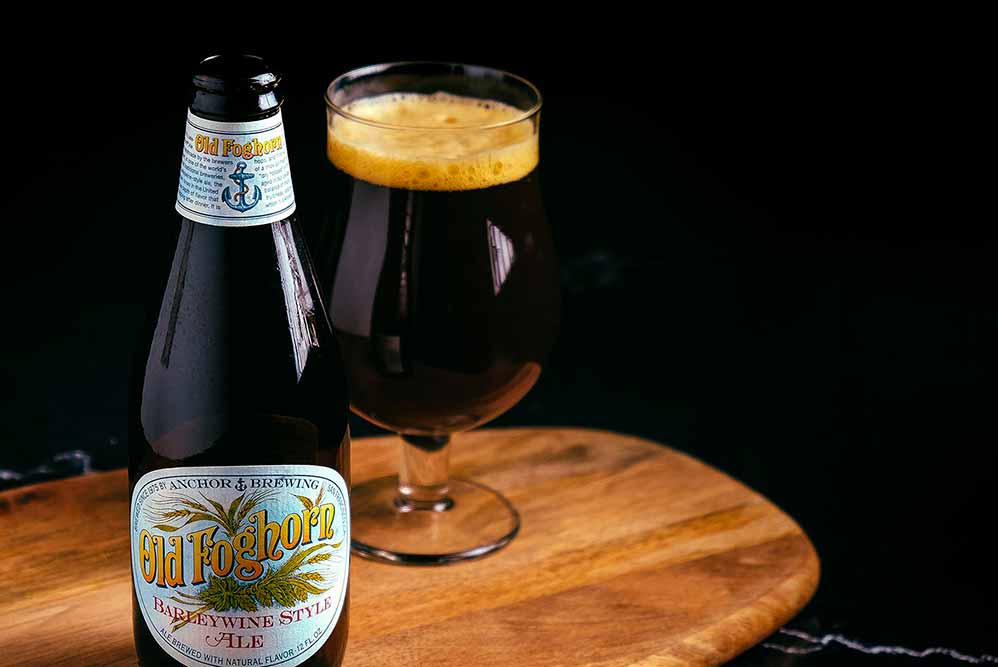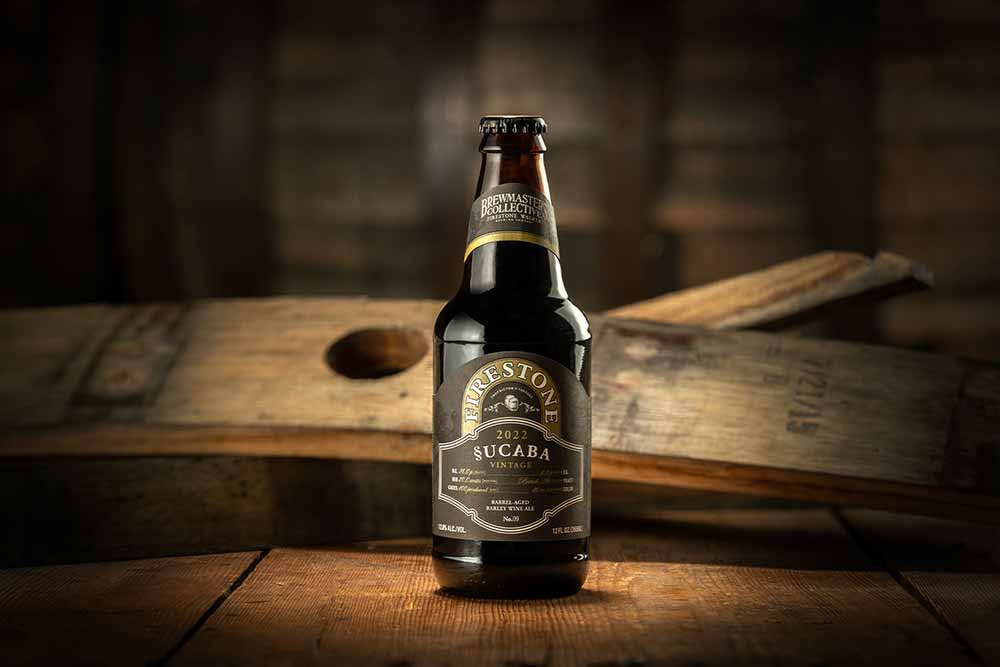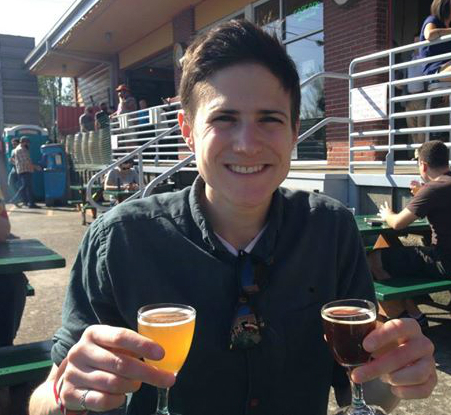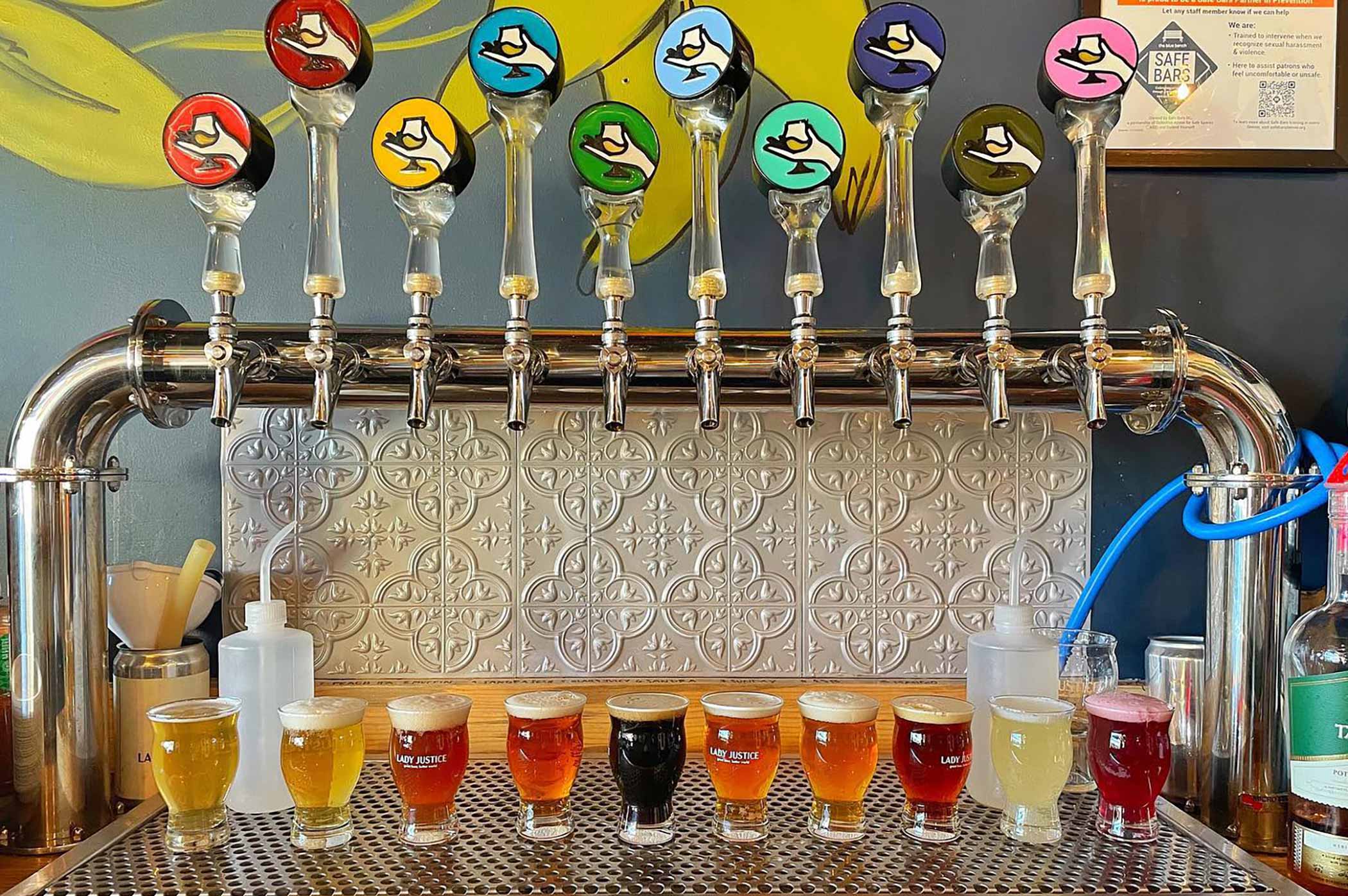Shop
Will You Be My Barleywine?
This isn't a trick question.
Want to Read More Like This Story?
What’s a beer called a wine that’s not a wine? No, this isn’t a scene from National Treasure where we’re asking you to be Nick Cage and solve the world’s greatest history mystery in ten seconds. Although you could probably figure out this riddle easily if you think about it. Answer: barleywine.
A strong, boozy, high-ABV beer style that’s malt forward, barleywine gained notoriety in the U.S. with iconic beers like Anchor Old Foghorn® Ale, Sierra Nevada’s Bigfoot, Firestone Walker Helldorado, and Deschutes Mirror Mirror, to name a few.
But not all of these beers are the same. Are you trying to trick us again with a riddle? Nope. They’re all barleywines, yes. But those first two are considered American barleywines, evolutions of their English cousins (those last two). So what exactly is the difference between the two, and where can we find great versions of both to drink today?
While the answers aren’t too tricky, nailing either barleywine can be, and so is understanding why in the whole wide world of beer styles we named this one after wine. ????♀️
So Barleywine Is a Beer, Not a Wine?
Exactly. Let’s get this out of the way right from the start: Barleywine is a beer style.
However, similarities exist between a barleywine and actual wine.
“They both age well over time, and both tend to have higher ABVs,” says Adam Robbings, co-founder and CEO of Reuben’s Brews, which recently won a gold medal in the “Old Ale or Strong Ale or Barleywine” category at the 2022 Great American Beer Festival for its English barleywine called Three Ryes Men. “I think the word ‘wine’ is used for the style as barleywine has a similar ABV to wines, up in the 10+% ABV range, but fundamentally, barleywine comes from sugars extracted from grain, while wine is fermented juice.”
Barleywines require an immense amount of malt boiled for an extended period to create a complex level of sugars, contributing to these beers’ higher ABVs and slightly sweeter malt-forward profile.
Boil everything down, and barleywine = beer.
In fact, in the U.S., you’ll see barleywine spelled as one word to differentiate it from wine legally, even though in the U.K. they spell the style as two words—barley wine*.
We won’t get into which country spells it correctly, but what we can agree on is that barleywine definitely started as a beer in the United Kingdom during the eighteenth century.
*Editor’s Note: For that reason, we will spell barleywine as one word in this piece.
A Quick History of the Barleywine
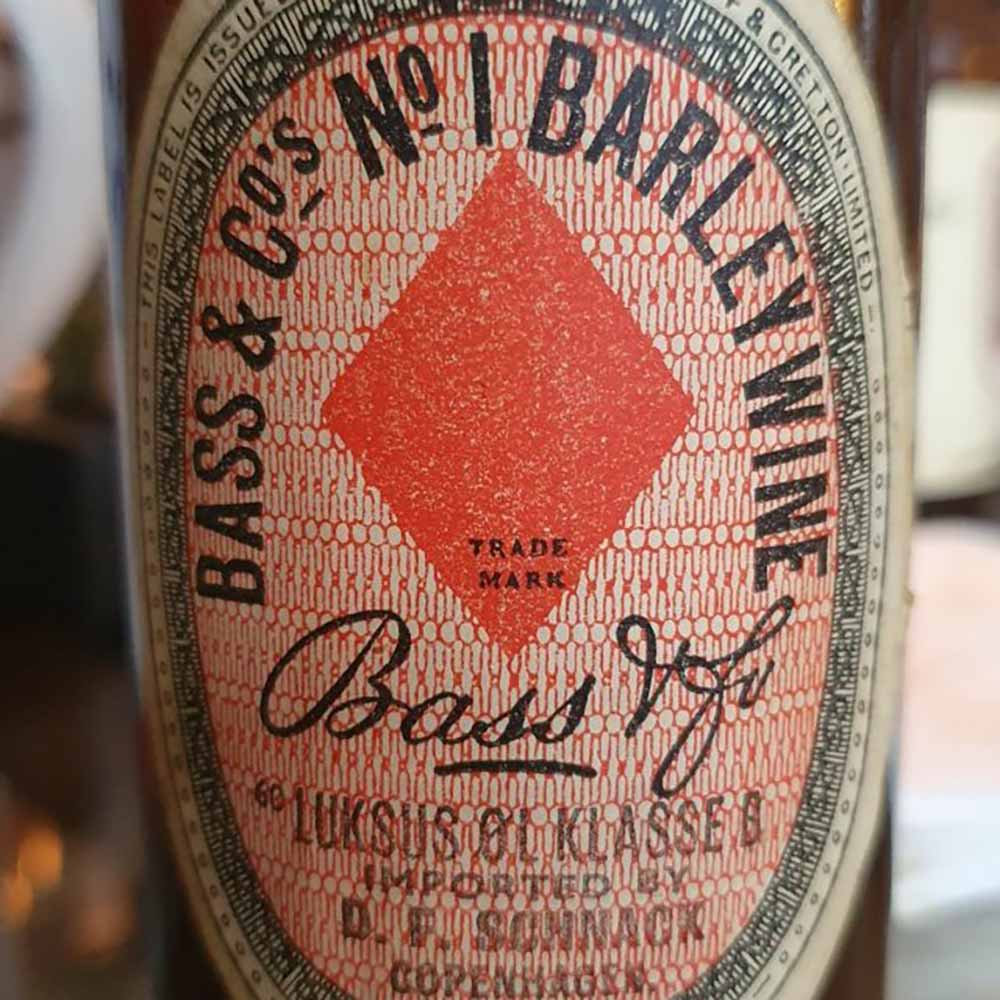
Photography courtesy of Revilo Nesnah | Untappd
Similar to IPAs, stouts, porters (actually, what is the difference between those two anyway?), and other beer styles, barleywines started in the United Kingdom.
A descendant of the nineteenth-century Scotch ale and Burton ales—darker beers known for their lower attenuation and higher residual sugars—barleywines were originally called old ales.
“They come from a different time when beer at this level of ABV was very rare,” says Robbings. “Barleywines developed a reputation as a special occasion beer, which somewhat carries on today.”
A sort of strong ale brewed for memorable moments, old ales (known as Scotch ales or wee heavies in Scotland) gained their name from an extended aging period in wooden casks.
Much like wine.
Plus, these beers also tended to include a high amount of barley.
Do you see where we’re going here?
Well, someone eventually caught on, too, putting two and two together. In 1872, Bass Brewery in Burton-on-Trent in the English Midlands coined the term “barleywine.” A moniker used to describe the brewery’s “No. 1” beer, barleywine eventually became its own style.
But it wouldn’t be until the latter part of the century that the barleywine made its way to America. Anchor claims the title of brewing the first American barleywine, releasing Old Foghorn® Ale in 1975.
And yes, the English and American barleywines have distinct differences.
What Is an English Barleywine?
First and foremost, English barleywines focus on high-quality pale and caramel malts—English malts specifically.
“For me, it’s really important that barleywines are very malt-focused but still pretty high in IBUs,” says Selvedge Brewing Director of Brewing Operations Josh Skinner. “It has to highlight malts like Maris Otter, Golden Promise—those classic British-based malts with many toasted bread flavors.”
A great English barleywine doesn’t just respect the malt themselves but also how they’re treated.
Brewers boil for longer when mashing in to bring out these malts’ beautiful deep, rich flavors.
“With those extended boil times, you start to get those caramelized flavors—molasses, toffee, darker fruit flavors,” says Skinner. “We rely on extended boiling times for color pickup, kettle characterization, and Maillard reactions…amplifying the flavors that Maris Otter and Golden Promise already have, but really cranking it up.”
According to the Beer Judge Certification Program (BJCP) definition of an English barleywine, the overall impression of this style should “showcase a malty richness and complex, intense flavors, [with] a chewy and rich body, with warming alcohol and a pleasant fruit or hoppy interest.”
In other words, while hops should have a presence, they’re not the team captain or even first string. Perhaps more like the benchwarmers, hops play a supporting role.
And while Skinner says you don’t technically need to use British hops, he thinks you should. “If you’re taking the time to brew such a big, ingredient-intensive beer, you should spring for hops like East Kent Goldings or maybe Fuggles,” he says.
The BJCP extends that list to include Northdown and Target hops as well.
Lastly, an English barleywine should use a British ale yeast “that will produce that ester profile you expect from any British-style beer,” says Skinner. “Sometimes, depending on what you’re using, that could translate as some subtle stone fruit esters, but I like the berry notes that some British ale yeast will produce in a big beer like a barleywine.”
All told, an English barleywine should hit a final alcohol content in the sweet spot of 8-12% ABV and IBUs anywhere from 35-70, according to Robbings.
These are big, bold, brash beers that put malt before all.
Similar to their American counterparts but with one massive difference.
What Is an American Barleywine?
In American craft beer, what do we love more than anything else? Again, this isn’t a trick question.
Answer: hops!
We love hops; we love hops so much. And for good reason, of course.
So when Anchor Brewing released Old Foghorn® Ale in 1975, then-owner Fritz Maytag did something slightly different to the classic English style.
He added Pacific Northwest American hops—Cascade specifically. And he amplified those Cascade hops through a dry hop.
Significantly hoppier, Old Foghorn® Ale put an American fingerprint on the English style.
The brewing foundations remain the same: tons of malt and a long boiling time, but the plug-and-play ingredients are where American barleywines make swaps.
Typically, you’ll find a grist of pale and crystal malts in American barleywines.
Skinner says American brewers often look to local or craft malters to sub in American-grown barley varieties with more character.
For Crystal malts, he says you can blend in a range of malts like C45, C90, or even a single percentage of C120 or Special B to get the color to where you want it to be.
Robbings points out that, whereas English barleywines might use up to 100 percent of a base malt, relying on a long boil to bring out the caramel notes, American recipes can add specialty malts—like caramel or brown malt—to get a more intense character.
“Here in the U.S., we put our own twist on the style by intensifying the flavor,” says Robbings. “American barleywines use more hops and malts to increase the caramel character.”
Although honestly, American barleywines can range in hue from the super golden Firestone Walker Helldorado to the deeper red, mahogany Sierra Nevada Bigfoot.
Above all, hops shine in an American barleywine.
“As far as hopping goes, an American barleywine is historically much more aggressively hopped than British-style barleywines,” says Skinner, indicating this style hits anywhere between 60-100 IBUs. “Personally, I like focusing on more classic Pacific Northwest (PNW) hop flavors like Chinook, maybe some Centennial, Cascade, of course, any classic ‘C’ hops that have that resinous piney character that plays really well in the style.”
Those danker PNW hops balance the residual sweetness from the high amounts of malt while a fairly vanilla American ale yeast just lightly rounds all the edges of this potentially brusk beer.
“I use…a bit more neutral yeast that won’t throw off a lot of esters,” says Skinner.
At the end of the day, Robbings says an American barleywine should finish between 8-12% ABV, just like an English version, but run on the higher side of IBUs for a danker, pinier yet balanced barleywine.
The Trick to Brewing a Barleywine
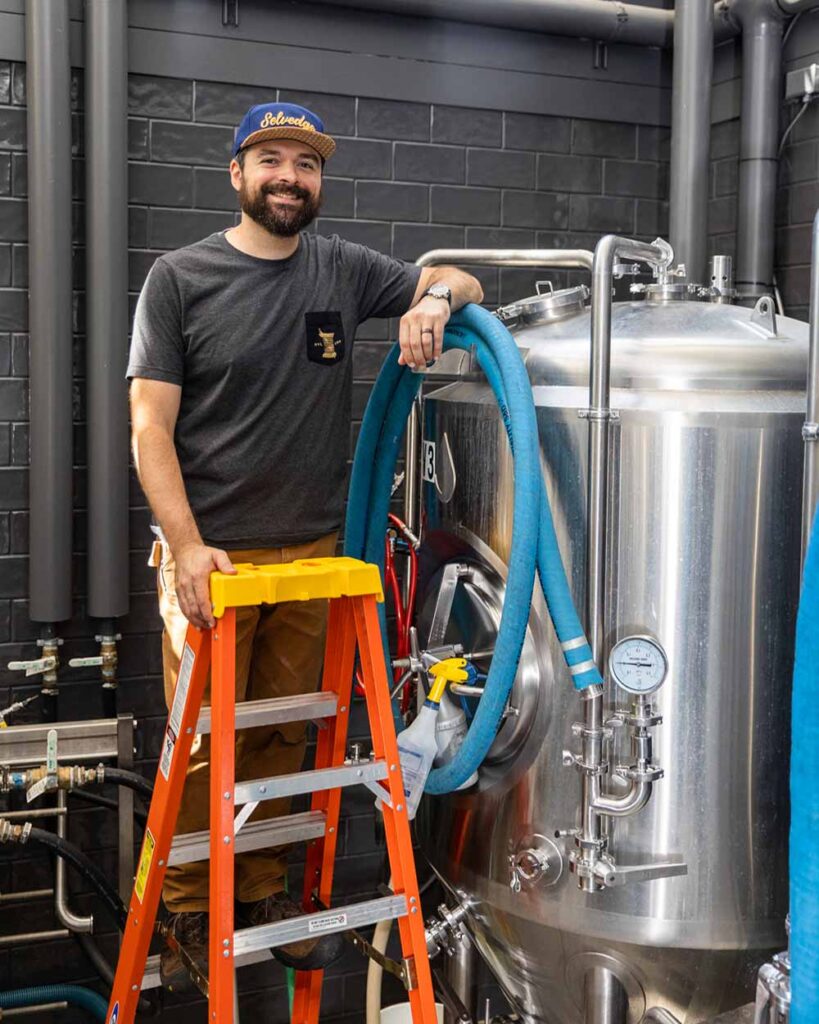
Selvedge Brewing Director of Brewing Operations, Josh Skinner | Photography courtesy of Selvedge Brewing
Regardless of English or American, barleywines can be tricky beer styles to brew. With barleywines, brewers need to hit a very high initial gravity of anywhere between twenty-four to the low-thirties degree Plato, depending on exactly what ABV you want and how much residual sweetness you want in that beer, says Skinner.
Robbings agrees, noting, “One of the biggest challenges is making sure the recipe has enough malt so that the gravity is high enough to reach the target ABV.”
Remember how we said you need a s**t ton of malt?
In Three Ryes Men, Reuben’s Brews adds three types of rye: malted, crystal, and flaked. The grist bill has forty-eight percent rye, “which brewers out there will recognize as a crazy amount, but we chose rye for its unique flavor and ability to give a more intense mouthfeel,” says Robbings. “We balance this with Chinook hops and then age the beer in a combination of bourbon and rye barrels.”
For Selvedge’s Woolly Mammoth, Skinner added a total of 1400 pounds ???? of grain for a 7-bbl tank of beer—a combination of Maris Otter, dark Crystal malt, and dark Munich malt.
Skinner likes to double mash, basically maxing out his mash ton twice without sparging (rinsing the grain) to “just hit your volume in your kettle and get a really high gravity before boiling that down further,” he says.
Similarly, at Reuben’s Brews, Robbings starts with two oversized mashes that combine into one high-gravity boil, which takes place over four hours.
At Selvedge, Skinner boils for three hours to caramelize the malt, maximizing color and flavor. “At some point, I’d like to do a twelve- to fourteen-hour boil, but I just haven’t been in a situation to do that,” he shares.
For Skinner, the highest hurdle comes during fermentation. Because of the sheer amount of malt in the recipe, you also need an equally “eye-popping amount of healthy yeast,” says Skinner. “You can’t just throw a crop straight from the lab into a barleywine, a beer this big, and expect to have good reliable results.”
To put things in perspective, Skinner shares that with most ales of similar gravity, he’ll pitch one million cells per milliliter per degree Plato. But for a barleywine, he’ll pitch somewhere between 1.5 million or 2 million cells per milliliter per degree Plato.
In a barleywine, everything is amplified. “You’re throwing your yeast into what will turn into a pretty inhospitable environment, and one of the biggest issues you can run into with barleywine is your fermentation stalling out on you, and then you’re ending up with an overly sweet cloying [beer] that didn’t hit your alcohol numbers…that’s not good; you shouldn’t release that,” says Skinner.
Robbings continues, “Keeping the yeast healthy and extended boil times all make it that much more challenging to balance that sweetness and bitterness.”
But if you nail everything, you’ll discover an elegant beer unlike any other, whether an English or American version.
Tasting an English and American Barleywine Side by Side
English barleywines pour out anywhere from gold to amber to brown with pleasant caramel and toffee aromas. “Flavors tend to lean heavy into malt,” says Robbings. “You may taste brown sugar, caramel, molasses, nuttiness, or breadiness.”
On the other hand, American barleywines “are often more bitter so that people will notice more citrus or fruity notes in addition to the sweet caramel aroma,” says Robbings. “American barleywines are still rich in malt flavor, but they usually have a noticeable hop bitterness to them too.”
Despite their complex profiles, Skinner says at breweries where he’s worked, barleywines won’t be the fastest movers. But that’s okay because these beers benefit from aging.
Barleywines Built for Barrel Aging
Think about it: Barleywines, whether English or American, employ a lot of these pale, caramel, or crystal malts, caramelized through a longer boil for those caramel, molasses, and dark fruit notes.
Barrel aging complements those notes perfectly, with barleywines picking up additional sweetness or vanillin from charred oak, whiskey, or bourbon barrels.
“Because these barrels are permeable, they allow micro levels of oxygen to slowly help bring out nuanced characters that you wouldn’t get otherwise.” says Robbings. “If you put a beer that may be overly sweet in a barrel, the tannins extract some of that sweetness over time and help balance the beer [while] oak adds complexity.”
Furthermore with an American barleywine, barrel aging mellows out that aggressive hoppiness. “They’re all big, boozy [beers] starting out, so you have some aggressive alcohol already present along with pronounced malt flavors and sometimes pronounced hop flavor that you will lose a lot of as that sits in the barrel,” says Skinner.
Since barleywines are already beers higher in alcohol content, letting them nap in a barrel means “these are definitely sipping beers!” exclaims Robbings.
So, Are English or American Barleywines More Popular?
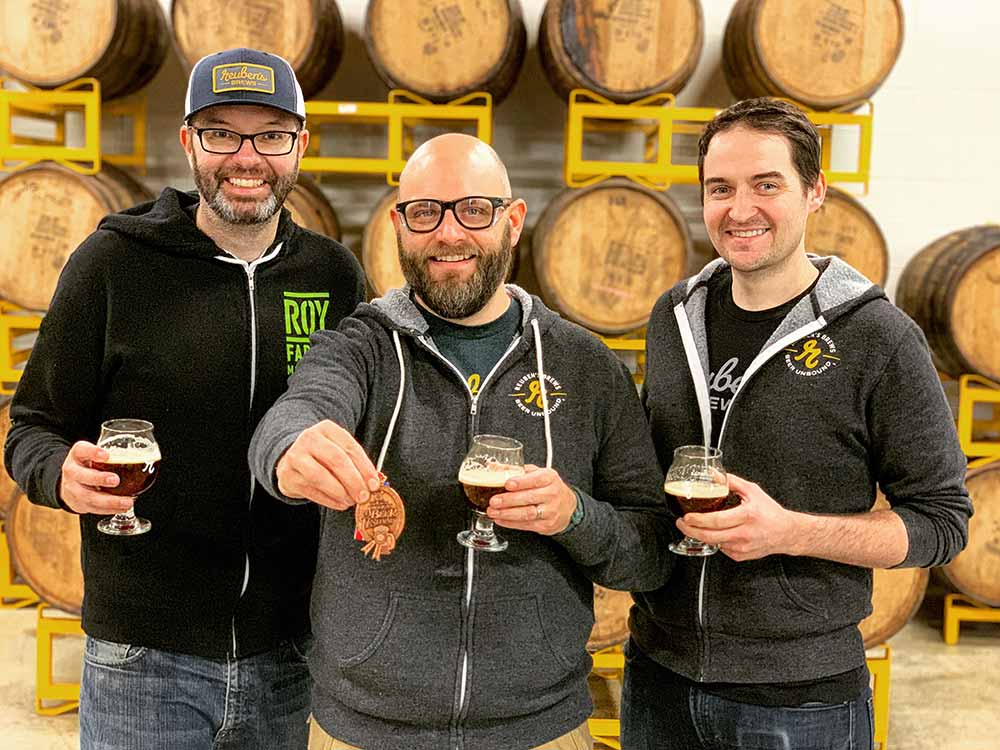
Photography courtesy of Reuben’s Brews
Interestingly enough, although in the United States, American barleywines initially dominated, English barleywines have come back into fashion.
According to Robbings, American palates shifted in the last decade or so as consumers looked for lower IBU beers. “Prior to 2015, intense bitterness was really popular, and it was common to see beers at eighty IBUs,” says Robbings. “Now beers tend to stay within fifty IBUs, and there’s a push toward sweeter beers.”
And while barleywines may never sell as quickly as a hazy or West Coast IPA, there is something to be said for enjoying a special beer brewed with intense care (and ingredients).
After all, that’s how this style started, right? A strong beer brewed for a memorable occasion only once in a while.
As to the riddle of which style you enjoy more—English or American barleywine— well, we’ll leave that up to you to answer.
A Few English and American Barleywines to Try
English Barleywines
Three Ryes Men – Reuben’s Brews
Seattle, WA
Winner of a gold medal in the “Old Ale or Strong Ale or Barleywine” category at the 2022 Great American Beer Festival, Three Ryes Men tastes like a “liquified, alcoholic Rolo,” according to Robbings. “It features a full body with malt-driven caramel and chocolate notes and layers of warming complexity.”
First brewed in 2018, Three Ryes Men didn’t start out as quintessentially English or American but did start to lean toward the former as the recipe developed. “I have always felt that the balance in an English barleywine is better [because] in such a soft, decadent, luxurious beer, having the hops in the background makes sense,” says Robbings. “Getting too high a hopping rate can often take over the show… We set out to achieve balance in an amazing beer, which ended up being a better representation of English barleywine. And, of course, being born in England, I was somewhat biased in my choice!”
Pouring a deep brown with ruby highlights, Three Ryes Men gives off aromas of chocolate, caramel candy, oak, bourbon, and maple syrup, Robbings notes, adding “from the first sip, you’ll notice flavors of rich caramel, chocolate, brown sugar, vanilla, toffee, and a little raisin in the background.”
Mirror Mirror – Deschutes Brewery
Bend, OR
A limited-edition beer that started when Deschutes brewed a double batch of its iconic Mirror Pond Pale Ale, Mirror Mirror takes its cues from an English barleywine.
Skinner’s first exposure to barleywines, Mirror Mirror “blew my mind, and from then on has always been a style I’ve really enjoyed,” he says.
Pouring a chestnut reddish/brown, Mirror Mirror has intricate layers of sticky toffee pudding—caramel, toffee, and nuts.
Sucaba – Firestone Walker Brewing Company
Paso Robles, CA
A beer Skinner always tries to have in his stash, Sucaba includes English barley along with a year-long nap in bourbon barrels. Expect very robust maltiness, dark chocolate, tobacco, and some oakiness from the barrels.
A classic that first showed up as a part of Firestone Walker’s Anniversary Ale blend in 2006, Sucaba picked up a bit of a cult-like following when it became a part of Firestone Walker’s Proprietor’s Vintage family of barrel-aged beers.
Although the beer took a two-year hiatus, returning only as a part of the Firestone Walker’s Brewmaster’s Collective last year.
Woolly Mammoth – Reuben’s Brews
Seattle, WA
Although officially categorized as an English barleywine, Skinner says Woolly Mammoth toes the line a bit. While the base includes Maris Otter, dark Munich, and a couple of dark crystal malts, Skinner adds a combination of American Columbus and British East Kent Golding hops along with an American ale yeast for a barleywine that “doesn’t fall neatly into American- or English-style barleywine in my opinion,” he says.
Regardless, it’s a delicious version of a barleywine.
Aged in Buffalo Trace bourbon barrels, Woolly Mammoth gives off “big toasted coconut, really potent toffee, some raisins, dark fruits, and marshmallow with lots of vanilla and this cool cherry liqueur thing,” says Skinner.
A decent body gives way to a “pretty luxurious mouthfeel,” as Skinner describes it. “It’s not hot but it lets you know you’re drinking a 16% ABV beer.”
Perpetual Contortion – False Idol Brewing
North Richland Hills, TX
A collaboration with 903 Brewers and Vector Brewing, Perpetual Contortion drank so smoothly for a 14% ABV beer. Aged for fifteen months in Iron Root whiskey barrels, this English barleywine expressed lovely notes of Panetone, the classic Italian sweet bread served around the holidays studded with dried fruit. We picked up notes of sweet cherry and sticky toffee pudding.
Any English Barleywine – Zebulon Artisan Ales
Weaverville, NC
Skinner clued us in to one of his favorite modern barleywine producers, Zebulon Artisan Ales in Weaverville, NC, about twenty minutes north of Asheville. According to Skinner, founder Mike Karnowski is always doing cool, but true-to-English-style barleywines in a bottle and a lot of times on draft as well.
“They are heavily inspired by historical examples, so that is where you go to find one-hundred-percent Maris Otter barleywine that’s hopped well above 100 IBUs mathematically with just East Kent Goldings and some crazy six- to twelve-hour boil,” says Skinner. “It’s always amazing the results he gets.”
American Barleywines
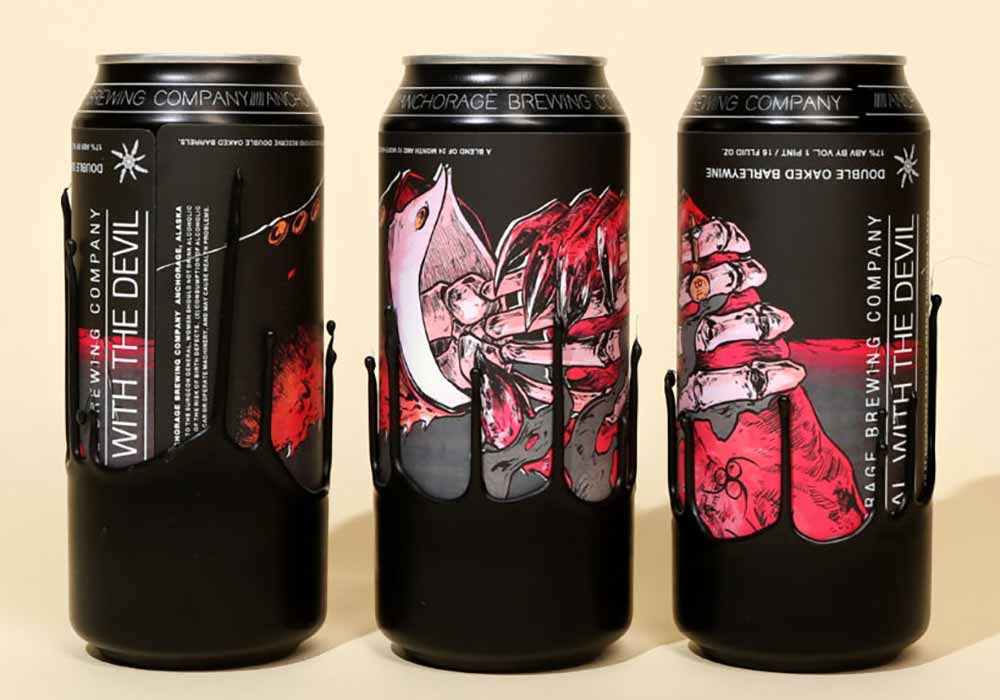
2020 release of Anchorage Brewing A Deal With the Devil in waxed dipped cans! | Photography courtesy of John A. Paradiso
Old Foghorn® Ale – Anchor Brewing Company
San Franciso, CA
The American barleywine that started it all, Old Foghorn® Ale brought a beer style to America that we have never seen before, but with its own twist.
A blend of two-row pale and caramel malt goes into a lengthy three-batch mash, meaning this recipe has three times the amount of malt as any other Anchor beer.
Along with a dry hop of Cascade. Hence, Anchor’s good ole West Coast interpretation.
Attaching “Old” to the title harkens back to barleywine’s history as an old ale while the “Foghorn” part is a nod to Anchor’s San Francisco roots.
A beer that bridged barleywine across the pond, Old Foghnorn® Ale still stands the test of time today as one of the most iconic versions of an American barleywine.
Bigfoot – Sierra Nevada Brewing Company
Chico, CA
Another classic that Skinner likes to have a couple verticals of, Sierra Nevada’s Bigfoot is probably the barleywine people recognize the most. First brewed in the winter of 1983, Bigfoot quickly became a cult classic for its ability to shape-shift over time. Each new “expedition” is perfect for cellaring, meaning folks (like Skinner) can collect and try this barleywine over time to detect new nuances.
The base beer includes a malt profile with a pretty big hit of whole-cone Pacific Northwest hops for a true-to-style American barleywine.
If there are two class American barleywines we recommend you try to understand the style, it’s the aforementioned Old Foghorn® Ale and Bigfoot here.
A Deal With the Devil – Anchorage Brewing Company
Anchorage, AK
One of the most popular contemporary versions of an American barleywine, A Deal With the Devil literally broke Tavour when first released on the app back in 2020.
So many people wanted to try this barleywine, with a starting gravity of thirty-seven degrees Plato and Galaxy hops aged in various spirits barrels, that they crashed the popular beer delivery app—4,272 of the 16-oz cans sold out in minutes. At $50 per can!
Skinner says it’s beers like A Deal With the Devil that prove there is hype around barleywines.
“A Deal With the Devil, a single bottle sells for like $70, so there is a lot of excitement around [the] style if people are willing to pay that much for a 500ml bottle or whatnot!” he says.
For 2023, Anchorage went back to a waxed dipped bottle format. This year’s version aged for ten months in Heaven Hill bourbon barrels before transferring to Willett bourbon barrels for an additional eleven months.
The devil is in the details, right?
Brewer’s Reserve Bourbon Barrel Barleywine – Central Waters Brewing Company
Amherst, WI
Winner of a 2008 Great American Beer Festival gold medal, Brewer’s Reserve Bourbon Barrel Barleywine utilizes oak bourbon barrels to develop layers of vanilla, buttery oak, nuttiness, and dried fruit.
With Central Waters’ version of an American barleywine, you can really experience how barrel aging affects barleywines over time.
This is an intricate beer that drinks beautifully no matter how long you store it.
“I’ve enjoyed that one every time I’ve had it,” says Skinner.
Helldorado – Firestone Walker Brewing Company
Paso Robles, CA
For an innovative take on the American barleywine, try Helldorado. Firestone Walker calls this an imperial blonde or blonde barleywine thanks to a slightly gold/sunset orange color not super typical in American barleywines.
El Dorado hops do give Helldorado a classic American barleywine base, while aging in barrels gives this beer a very interesting flavor matrix—honey, vanilla, toasted malt, and even some lavender according to Firestone Walker.

